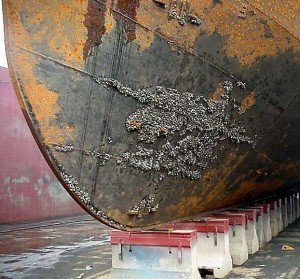New Kiwi research has found that biofouling mussels may be more likely to make their home on the hull of noisy ship than on a quiet one.
 The research, recently published in the journal Biofouling, reported that mussel larvae settle faster on surfaces when exposed to underwater noise. Scientists from NIWA and Auckland University undertook the research to learn more about what factors are involving in biofouling, a phenomenon which costs the shipping industry millions of dollars.
The research, recently published in the journal Biofouling, reported that mussel larvae settle faster on surfaces when exposed to underwater noise. Scientists from NIWA and Auckland University undertook the research to learn more about what factors are involving in biofouling, a phenomenon which costs the shipping industry millions of dollars.
Biofouling occurs when organisms, such as algae or shellfish, accumulate on wet surfaces. This accumulation of living material is a problem particularly for ships as the layer of organic matter causes drag and may carry invasive species between ports.
The specific noise used in the experiments was an underwater recording of a ship docked with the on board generator running. The recording was played to tanks of green lipped mussel (Perna canaliculus) larvae at either high or low volume, or not all in the case of the control group. The researchers found that the larvae exposed to the loudest playback of the noise through submersible speakers were the fastest to settle on a surface and start growing.
The authors of the research noted possible implications of their findings, stating in the article:
“If vessel sound is found to be an important factor in promoting hull fouling by mussels, then dampening or eliminating sound production in vessels, such as by switching to a shore-based electrical supply whilst vessels are at berth, would have the potential to reduce the extensive range of problems that fouling and translocation of mussels creates.”
The research has been noted by several media outlets:
MSN NZ News: Noisy ships attract fouling: NZ research
Radio New Zealand: Noise draws mussels to ships
TV3 News: Noisy ships attract fouling – NZ research
The original NIWA release can be found here.